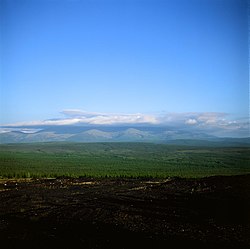Verkhoyansky District
Верхоянский улус | |
|---|---|
| Other transcription(s) | |
| • Sakha | Үөһээ Дьааҥы улууhа |
 Mat-Gora, Verkhoyansky District | |
 Location of Verkhoyansky District in the Sakha Republic | |
| Coordinates: 67°33′N 133°23′E / 67.550°N 133.383°E | |
| Country | Russia |
| Federal subject | Sakha Republic[1] |
| Established | January 5, 1967[2] |
| Administrative center | Batagay[3] |
| Area | |
| • Total | 137,400 km2 (53,100 sq mi) |
| Population | |
| • Total | 12,815 |
| • Density | 0.093/km2 (0.24/sq mi) |
| • Urban | 46.2% |
| • Rural | 53.8% |
| Administrative structure | |
| • Administrative divisions | 1 Towns under district jurisdiction, 2 Settlements, 14 Rural okrugs |
| • Inhabited localities[3] | 1 cities/towns, 2 Urban-type settlements[5], 26 rural localities |
| Municipal structure | |
| • Municipally incorporated as | Verkhoyansky Municipal District[6] |
| • Municipal divisions[7] | 3 urban settlements, 14 rural settlements |
| Time zone | UTC+10 (MSK+7 |
| OKTMO ID | 98616000 |
| Website | https://mr-verhojanskij.sakha.gov.ru/ |
Verkhoyansky District (Russian: Верхоя́нский улу́с; Yakut: Үөһээ Дьааҥы улууһа, Üöhee Caaŋı uluuha, IPA: [ˈyøheː ɟaːŋɯ uluːha]) is an administrative[1] and municipal[6] district (raion, or ulus), one of the thirty-four in the Sakha Republic, Russia. It is located in the northern central part of the republic and borders with Ust-Yansky District in the northeast, Momsky District in the east, Tomponsky District in the south, Kobyaysky District in the southwest, Eveno-Bytantaysky National District in the west, and with Bulunsky District in the northwest. The area of the district is 137,400 square kilometers (53,100 sq mi).[3] Its administrative center is the urban locality (a settlement) of Batagay.[3] Population: 12,815 (2010 Census);[4] 13,666 (2002 Census);[9] 24,259 (1989 Soviet census).[10] The population of Batagay accounts for 34.1% of the district's total population.[4]
- ^ a b Constitution of the Sakha Republic
- ^ Cite error: The named reference
SEPMwas invoked but never defined (see the help page). - ^ a b c d e Registry of the Administrative-Territorial Divisions of the Sakha Republic
- ^ a b c Russian Federal State Statistics Service (2011). Всероссийская перепись населения 2010 года. Том 1 [2010 All-Russian Population Census, vol. 1]. Всероссийская перепись населения 2010 года [2010 All-Russia Population Census] (in Russian). Federal State Statistics Service.
- ^ The count of urban-type settlements may include the work settlements, the resort settlements, the suburban (dacha) settlements, as well as urban-type settlements proper.
- ^ a b Law #172-Z #351-III
- ^ Law #173-Z #354-III
- ^ "Об исчислении времени". Официальный интернет-портал правовой информации (in Russian). June 3, 2011. Retrieved January 19, 2019.
- ^ Federal State Statistics Service (May 21, 2004). Численность населения России, субъектов Российской Федерации в составе федеральных округов, районов, городских поселений, сельских населённых пунктов – районных центров и сельских населённых пунктов с населением 3 тысячи и более человек [Population of Russia, Its Federal Districts, Federal Subjects, Districts, Urban Localities, Rural Localities—Administrative Centers, and Rural Localities with Population of Over 3,000] (XLS). Всероссийская перепись населения 2002 года [All-Russia Population Census of 2002] (in Russian).
- ^ Всесоюзная перепись населения 1989 г. Численность наличного населения союзных и автономных республик, автономных областей и округов, краёв, областей, районов, городских поселений и сёл-райцентров [All Union Population Census of 1989: Present Population of Union and Autonomous Republics, Autonomous Oblasts and Okrugs, Krais, Oblasts, Districts, Urban Settlements, and Villages Serving as District Administrative Centers]. Всесоюзная перепись населения 1989 года [All-Union Population Census of 1989] (in Russian). Институт демографии Национального исследовательского университета: Высшая школа экономики [Institute of Demography at the National Research University: Higher School of Economics]. 1989 – via Demoscope Weekly.

